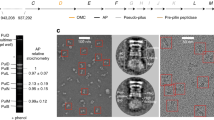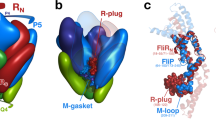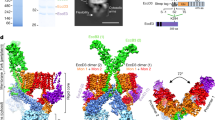Abstract
Type III secretion systems (T3SSs) are bacterial membrane–embedded nanomachines designed to export specifically targeted proteins from the bacterial cytoplasm. Secretion through T3SS is governed by a subset of inner membrane proteins termed the 'export apparatus'. We show that a key member of the Shigella flexneri export apparatus, MxiA, assembles into a ring essential for secretion in vivo. The ring-forming interfaces are well-conserved in both nonflagellar and flagellar homologs, implying that the ring is an evolutionarily conserved feature in these systems. Electron cryo-tomography revealed a T3SS-associated cytoplasmic torus of size and shape corresponding to those of the MxiA ring aligned to the secretion channel located between the secretion pore and the ATPase complex. This defines the molecular architecture of the dominant component of the export apparatus and allows us to propose a model for the molecular mechanisms controlling secretion.
This is a preview of subscription content, access via your institution
Access options
Subscribe to this journal
Receive 12 print issues and online access
$189.00 per year
only $15.75 per issue
Buy this article
- Purchase on Springer Link
- Instant access to full article PDF
Prices may be subject to local taxes which are calculated during checkout






Similar content being viewed by others
References
Cornelis, G.R. The type III secretion injectisome, a complex nanomachine for intracellular 'toxin' delivery. Biol. Chem. 391, 745–751 (2010).
Patel, J.C. & Galan, J.E. Manipulation of the host actin cytoskeleton by Salmonella–all in the name of entry. Curr. Opin. Microbiol. 8, 10–15 (2005).
Blocker, A.J. et al. What's the point of the type III secretion system needle? Proc. Natl. Acad. Sci. USA 105, 6507–6513 (2008).
Erhardt, M., Namba, K. & Hughes, K.T. Bacterial nanomachines: the flagellum and type III injectisome. Cold Spring Harb. Perspect. Biol. 2, a000299 (2010).
Marlovits, T.C. & Stebbins, C.E. Type III secretion systems shape up as they ship out. Curr. Opin. Microbiol. 13, 47–52 (2010).
Deane, J.E., Abrusci, P., Johnson, S. & Lea, S.M. Timing is everything: the regulation of type III secretion. Cell. Mol. Life Sci. 67, 1065–1075 (2010).
Diepold, A., Wiesand, U. & Cornelis, G.R. The assembly of the export apparatus (YscR,S,T,U,V) of the Yersinia type III secretion apparatus occurs independently of other structural components and involves the formation of an YscV oligomer. Mol. Microbiol. 82, 502–514 (2011).
Wagner, S. et al. Organization and coordinated assembly of the type III secretion export apparatus. Proc. Natl. Acad. Sci. USA 107, 17745–17750 (2010).
Li, H. & Sourjik, V. Assembly and stability of flagellar motor in Escherichia coli. Mol. Microbiol. 80, 886–899 (2011).
Minamino, T., Imada, K. & Namba, K. Mechanisms of type III protein export for bacterial flagellar assembly. Mol. Biosyst. 4, 1105–1115 (2008).
Minamino, T., Imada, K. & Namba, K. Molecular motors of the bacterial flagella. Curr. Opin. Struct. Biol. 18, 693–701 (2008).
Diepold, A. et al. Deciphering the assembly of the Yersinia type III secretion injectisome. EMBO J. 29, 1928–1940 (2010).
Zhu, K., Gonzalez-Pedrajo, B. & Macnab, R.M. Interactions among membrane and soluble components of the flagellar export apparatus of Salmonella. Biochemistry 41, 9516–9524 (2002).
McMurry, J.L., Van Arnam, J.S., Kihara, M. & Macnab, R.M. Analysis of the cytoplasmic domains of Salmonella FlhA and interactions with components of the flagellar export machinery. J. Bacteriol. 186, 7586–7592 (2004).
Bange, G. et al. FlhA provides the adaptor for coordinated delivery of late flagella building blocks to the type III secretion system. Proc. Natl. Acad. Sci. USA 107, 11295–11300 (2010).
Minamino, T. et al. Interaction of a bacterial flagellar chaperone FlgN with FlhA is required for efficient export of its cognate substrates. Mol. Microbiol. 83, 775–788 (2012).
Worrall, L.J., Vuckovic, M. & Strynadka, N.C. Crystal structure of the C-terminal domain of the Salmonella type III secretion system export apparatus protein InvA. Prot. Sci. 19, 1091–1096 (2010).
Saijo-Hamano, Y. et al. Structure of the cytoplasmic domain of FlhA and implication for flagellar type III protein export. Mol. Microbiol. 76, 260–268 (2010).
Moore, S.A. & Jia, Y. Structure of the cytoplasmic domain of the flagellar secretion apparatus component FlhA from Helicobacter pylori. J. Biol. Chem. 285, 21060–21069 (2010).
Lilic, M., Quezada, C.M. & Stebbins, C.E. A conserved domain in type III secretion links the cytoplasmic domain of InvA to elements of the basal body. Acta Crystallogr. D Biol. Crystallogr. 66, 709–713 (2010).
Andrews, G.P. & Maurelli, A.T. mxiA of Shigella flexneri 2a, which facilitates export of invasion plasmid antigens, encodes a homolog of the low-calcium-response protein, LcrD, of Yersinia pestis. Infect. Immun. 60, 3287–3295 (1992).
Ashida, H. et al. Shigella deploy multiple countermeasures against host innate immune responses. Curr. Opin. Microbiol. 14, 16–23 (2011).
Spreter, T. et al. A conserved structural motif mediates formation of the periplasmic rings in the type III secretion system. Nat. Struct. Mol. Biol. 16, 468–476 (2009).
Worrall, L.J., Lameignere, E. & Strynadka, N.C. Structural overview of the bacterial injectisome. Curr. Opin. Microbiol. 14, 3–8 (2011).
Yip, C.K. et al. Structural characterization of the molecular platform for type III secretion system assembly. Nature 435, 702–707 (2005).
Sanowar, S. et al. Interactions of the transmembrane polymeric rings of the Salmonella enterica serovar Typhimurium type III secretion system. mBio 1, e00158-10 (2010).
Lee, L.K., Ginsburg, M.A., Crovace, C., Donohoe, M. & Stock, D. Structure of the torque ring of the flagellar motor and the molecular basis for rotational switching. Nature 466, 996–1000 (2010).
Schraidt, O. & Marlovits, T.C. Three-dimensional model of Salmonella's needle complex at subnanometer resolution. Science 331, 1192–1195 (2011).
Hodgkinson, J.L. et al. Three-dimensional reconstruction of the Shigella T3SS transmembrane regions reveals 12-fold symmetry and novel features throughout. Nat. Struct. Mol. Biol. 16, 477–485 (2009).
Goodsell, D.S. & Olson, A.J. Structural symmetry and protein function. Annu. Rev. Biophys. Biomol. Struct. 29, 105–153 (2000).
Thomas, D.R., Francis, N.R., Xu, C. & DeRosier, D.J. The three-dimensional structure of the flagellar rotor from a clockwise-locked mutant of Salmonella enterica serovar Typhimurium. J. Bacteriol. 188, 7039–7048 (2006).
Chen, S. et al. Structural diversity of bacterial flagellar motors. EMBO J. 30, 2972–2981 (2011).
Liu, J. et al. Intact flagellar motor of Borrelia burgdorferi revealed by cryo-electron tomography: evidence for stator ring curvature and rotor/C-ring assembly flexion. J. Bacteriol. 191, 5026–5036 (2009).
Minamino, T. et al. Roles of the extreme N-terminal region of FliH for efficient localization of the FliH-FliI complex to the bacterial flagellar type III export apparatus. Mol. Microbiol. 74, 1471–1483 (2009).
Ibuki, T. et al. Common architecture of the flagellar type III protein export apparatus and F- and V-type ATPases. Nat. Struct. Mol. Biol. 18, 277–282 (2011).
Pallen, M.J., Bailey, C.M. & Beatson, S.A. Evolutionary links between FliH/YscL-like proteins from bacterial type III secretion systems and second-stalk components of the FoF1 and vacuolar ATPases. Prot. Sci. 15, 935–941 (2006).
Imada, K., Minamino, T., Tahara, A. & Namba, K. Structural similarity between the flagellar type III ATPase FliI and F1-ATPase subunits. Proc. Natl. Acad. Sci. USA 104, 485–490 (2007).
Zarivach, R., Vuckovic, M., Deng, W., Finlay, B.B. & Strynadka, N.C. Structural analysis of a prototypical ATPase from the type III secretion system. Nat. Struct. Mol. Biol. 14, 131–137 (2007).
Minamino, T., Morimoto, Y.V., Hara, N. & Namba, K. An energy transduction mechanism used in bacterial flagellar type III protein export. Nature Commun. 2, 475 (2011).
Paul, K., Erhardt, M., Hirano, T., Blair, D.F. & Hughes, K.T. Energy source of flagellar type III secretion. Nature 451, 489–492 (2008).
Minamino, T. & Namba, K. Distinct roles of the FliI ATPase and proton motive force in bacterial flagellar protein export. Nature 451, 485–488 (2008).
Wilharm, G. et al. Yersinia enterocolitica type III secretion depends on the proton motive force but not on the flagellar motor components MotA and MotB. Infect. Immun. 72, 4004–4009 (2004).
Galperin, M., Dibrov, P.A. & Glagolev, A.N. delta mu H+ is required for flagellar growth in Escherichia coli. FEBS Lett. 143, 319–322 (1982).
Hara, N., Namba, K. & Minamino, T. Genetic Characterization of Conserved Charged Residues in the Bacterial Flagellar Type III Export Protein FlhA. PLoS ONE 6, e22417 (2011).
Minamino, T., Kinoshita, M., Imada, K. & Namba, K. Interaction between FliI ATPase and a flagellar chaperone FliT during bacterial flagellar protein export. Mol. Microbiol. 83, 168–178 (2012).
Akeda, Y. & Galan, J.E. Chaperone release and unfolding of substrates in type III secretion. Nature 437, 911–915 (2005).
Thomas, J., Stafford, G.P. & Hughes, C. Docking of cytosolic chaperone-substrate complexes at the membrane ATPase during flagellar type III protein export. Proc. Natl. Acad. Sci. USA 101, 3945–3950 (2004).
Berg, H.C. The rotary motor of bacterial flagella. Annu. Rev. Biochem. 72, 19–54 (2003).
Murphy, G.E., Leadbetter, J.R. & Jensen, G.J. In situ structure of the complete Treponema primitia flagellar motor. Nature 442, 1062–1064 (2006).
Blocker, A. et al. Structure and composition of the Shigella flexneri “needle complex”, a part of its type III secreton. Mol. Microbiol. 39, 652–663 (2001).
Wolf, S., Freier, E., Potschies, M., Hofmann, E. & Gerwert, K. Directional proton transfer in membrane proteins achieved through protonated protein-bound water molecules: a proton diode. Angew. Chem. Int. Ed. Engl. 49, 6889–6893 (2010).
Miroux, B. & Walker, J.E. Over-production of proteins in Escherichia coli: mutant hosts that allow synthesis of some membrane proteins and globular proteins at high levels. J. Mol. Biol. 260, 289–298 (1996).
Solano, C. et al. Genetic reductionist approach for dissecting individual roles of GGDEF proteins within the c-di-GMP signaling network in Salmonella. Proc. Natl. Acad. Sci. USA 106, 7997–8002 (2009).
Hendrixson, D.R. & DiRita, V.J. Transcription of sigma54-dependent but not sigma28-dependent flagellar genes in Campylobacter jejuni is associated with formation of the flagellar secretory apparatus. Mol. Microbiol. 50, 687–702 (2003).
Kenjale, R. et al. The needle component of the type III secreton of Shigella regulates the activity of the secretion apparatus. J. Biol. Chem. 280, 42929–42937 (2005).
Marteyn, B. et al. Modulation of Shigella virulence in response to available oxygen in vivo. Nature 465, 355–358 (2010).
Rayment, I. Reductive alkylation of lysine residues to alter crystallization properties of proteins. Methods Enzymol. 276, 171–179 (1997).
Winter, G. xia2: an expert system for macromolecular crystallography data reduction. J. Appl. Crystallogr. 43, 186–190 (2010).
The CCP4 suite: programs for protein crystallography. Acta Crystallogr. D Biol. Crystallogr. 50, 760–763 (1994).
Emsley, P., Lohkamp, B., Scott, W.G. & Cowtan, K. Features and development of Coot. Acta Crystallogr. D Biol. Crystallogr. 66, 486–501 (2010).
Blanc, E. et al. Refinement of severely incomplete structures with maximum likelihood in BUSTER-TNT. Acta Crystallogr. D Biol. Crystallogr. 60, 2210–2221 (2004).
Agulleiro, J.I. & Fernandez, J.J. Fast tomographic reconstruction on multicore computers. Bioinformatics 27, 582–583 (2011).
Nicastro, D. et al. The molecular architecture of axonemes revealed by cryoelectron tomography. Science 313, 944–948 (2006).
Acknowledgements
We thank N.C. Strynadka for access to InvA coordinates ahead of publication, P. Sansonetti (Institute Pasteur, Paris) for providing the polyclonal antibodies to Ipa proteins, I. Lasa (Universidad Pública de Navarra, Pamplona) for the pKO3blue plasmid, L. De Colibus, C. King and members of the Lea group for general assistance, the staff of the protein crystallography beamlines at the European Synchrotron Radiation Source, Grenoble (France) and DIAMOND facility, Didcot (UK) for assistance in data collection, and S.K. Mazmanian for use of the microaerobic chamber. P.A. is funded by grant 083599/Z/07/Z and J.E.D. by grant WT083599MA, both from the Wellcome Trust to S.M.L.; S.J. is funded by grant G0900888 from the UK Medical Research Council to S.M.L. and C.M.T.; P.R. is funded by the Oxford Martin School Vaccine Design Institute of which S.M.L. is codirector. M.V.-I. is funded by FP7 Marie Curie EIMID-IAPP-217768 grant. M.B. and G.J.J. were supported by the Howard Hughes Medical Institute.
Author information
Authors and Affiliations
Contributions
J.E.D., S.J. and S.M.L. initiated the project, which P.A. later joined; S.M.L. and C.M.T. supervised the project. M.E.F. and J.E.D. designed the MxiAC expression vector and did protein expression and stability trials. P.A. performed the large-scale purification, methylation, crosslinking and SPR of MxiAC and its mutants. S.J. performed the MALS experiments. P.A. designed the 'export apparatus' co-expression vectors and purified the recombinant complex. P.A. crystallized MxiAC and optimized crystals for data collection, and S.M.L. soaked and handled crystals for data collection. P.A., P.R. and S.M.L. contributed to the data collection, structure determination and model building. C.M.T. and M.V.-I. designed and performed the complementation and invasion assays in S. flexneri. D.R.H. created the C. jejuni strains, and M.D.B. and G.J.J. designed and performed cryo-EM tomography. P.A., S.J. and S.M.L. analyzed data and wrote the manuscript. All authors read and approved the manuscript.
Corresponding author
Ethics declarations
Competing interests
The authors declare no competing financial interests.
Supplementary information
Supplementary Text and Figures
Supplementary Figures 1–6 and Supplementary Tables 1–3 (PDF 3013 kb)
Rights and permissions
About this article
Cite this article
Abrusci, P., Vergara-Irigaray, M., Johnson, S. et al. Architecture of the major component of the type III secretion system export apparatus. Nat Struct Mol Biol 20, 99–104 (2013). https://doi.org/10.1038/nsmb.2452
Received:
Accepted:
Published:
Issue Date:
DOI: https://doi.org/10.1038/nsmb.2452
This article is cited by
-
The FlgN chaperone activates the Na+-driven engine of the Salmonella flagellar protein export apparatus
Communications Biology (2021)
-
Control of membrane barrier during bacterial type-III protein secretion
Nature Communications (2021)
-
A positive charge region of Salmonella FliI is required for ATPase formation and efficient flagellar protein export
Communications Biology (2021)
-
The FlhA linker mediates flagellar protein export switching during flagellar assembly
Communications Biology (2021)
-
The substrate specificity switch FlhB assembles onto the export gate to regulate type three secretion
Nature Communications (2020)



